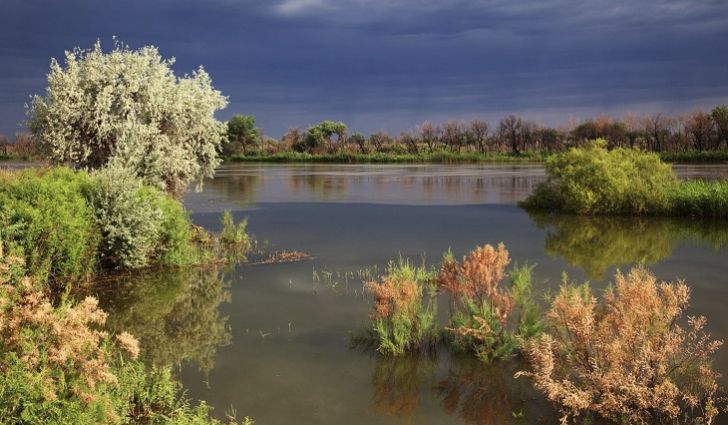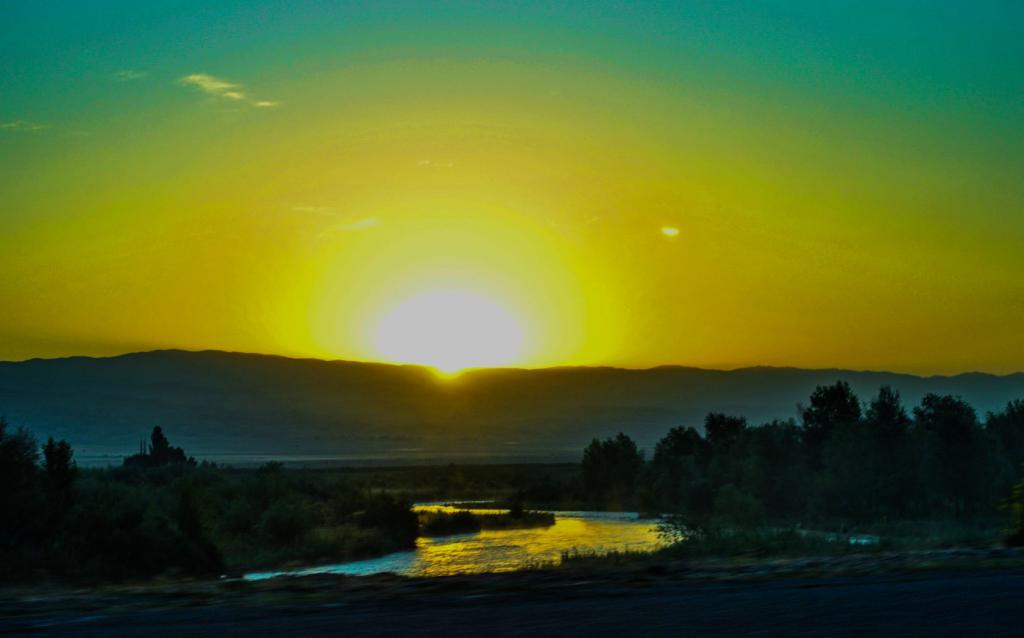The number of rivers in Kazakhstan exceeds 39 thousand. They are unevenly distributed over the territory, since Kazakhstan has desert arid lands, and there are mountains and elevations. The areas of Altai, Ile Alatau and the Zhatysu ridge have a dense river network. There are very few rivers in the deserts.
Kazakhstan rivers (list)
They mainly belong to the basins of the Caspian and Aral Seas, and only a few water flows into the Kara Sea, far to the north. Most of the rivers and lakes of Kazakhstan are not very large and full of water. List of large water arteries (length over 1000 kilometers):
- Irtysh;
- Ishim;
- Or;
- Syr Darya;
- Tobol;
- Ural;
- Chew.
These names are mostly Russian. Locals call them a little differently. List of Kazakhstan's rivers in the Kazakh language: Ertis, Esil, Oral, Syr Darya, Tobyl, Ilyanі, Chu.
In addition to large rivers, there are many small shallow streams. As already mentioned, they are too numerous, we list only the main small (up to 1000 kilometers in length) rivers of Kazakhstan. Their list includes: Big Uzen, Ilek, Irgiz, Small Uzen, Nura, Sagiz, Sarysu, Turgai, Talas, Will, Emba. Naturally, it is far from incomplete. This article will describe in detail only some of the large and small rivers of Kazakhstan. The list is alphabetically.
Irtysh River
Irtysh is a river that flows in China, Kazakhstan and Russia. This is the largest tributary of the Ob. Irtysh waters pass a 4248 km long path. More than the Ob River. Together with the great Siberian waterway, the Irtysh forms the longest water stream in Russia and the second longest in Asia. It is 5410 kilometers. Naturally, the Irtysh is longer than other rivers of Kazakhstan. The list of tributaries in the republic: Burchun, Bukhtarma, Kalzhir, Kurchum, Narym, Ulba, Uba.
1700 kilometers flow through the territory of Kazakhstan. Starting on the Sino-Mongolian border (Mongolian Altai), the river carries its waters to Kazakhstan. There, near the source, it is called Black Irtysh or Ertsisyhe. The Irtysh River is included in the list of transboundary rivers of Kazakhstan, which creates problems, because the water of the river is actively used by China.
In Kazakhstan, the river flows into the Zaysan depression and soon flows into the shallow fresh lake Zaysan. The mouth of the Black Irtysh forms a large marshy delta. In addition to this river, many more water flows from the ranges of Saur and Tarbagatay and Rudny Altai into the Zaysan Lake . From the lake flows the Irtysh, already more full-flowing. It flows in a northwest direction, passing along the Bukhtarma hydroelectric power station. It flows past the city of Serebryansk and the Ust-Kamennogorsk hydroelectric station. Following is the Shulbinsk hydroelectric station and the city of Semey. Not reaching Pavlodar, the river shares part of the water with the Irtysh channel - Karaganda, laid in a westerly direction. Being on the territory of Russia, it flows into the Ob in the Khantymansiysk region.
Irtysh is appreciated by fishermen. It has many types of fish. Of the noble sturgeon, sterlet, stellate sturgeon, nelma. But there is a fish and more common - crucian carp, pike, perch. For breeding in the Irtysh, Baikal omul and common carp were released.
Ishim
One of the tributaries of the Irtysh River, the longest in Kazakhstan. Ishim also flows in Russia, like other large rivers of Kazakhstan. List of tributaries: Akkanburlyk, Zhabay, Imanburlyk, Coluton, Terisakan. A river begins in the low mountains of Niyaz (Kazakh small hills). Then 775 kilometers flow in a westerly direction, absorbing water flows flowing from the Kokshetau Upland and from the mountain spurs of Ulytau.
In the upper reaches, the Ishim valley is narrow with rocky shores. After the city of Astana, the valley becomes wider, and after Atbasar the direction changes to the south-west. Passing the city of Derzhavinsk, Ishim sharply turns its channel to the north. Then, already on the territory of Russia, Ishim flows along the West Siberian Plain. It flows into the Irtysh river near the village of Ust-Ishim.
The food at the Ishim River is mostly snowy; due to melting, it receives 80 percent of its annual runoff. The maximum water flow rate is 1100 cubic meters per second near the city of Astana in the upper reaches. In the river there are: pike, burbot, perch, bream, pike perch, dace, roach, char, gudgeon, ruff, plucking.
Tobol
Another river of Kazakhstan, which flows on the territory of Russia, is the same as the Irtysh and Ishim. Only the upper reaches of this river are in Kazakhstan, the middle and lower are on the West Siberian Plain. In the upper reaches, the water freezes in November, and in the lower reaches - in late October or early November. There are many fish in the river. This is burbot, perch, ruff, rudd, roach, crucian carp, perch, burbot, pike, ide, bream.
Syr Darya
The Syr Darya River ranks second in terms of length and fullness throughout Central Asia. She passes on her way three countries - Kazakhstan, Uzbekistan and Tajikistan. The Syr Darya is formed at the confluence of two rivers - Kardarya and Naryn in the Ferghana Valley. It ends when it flows into the northern part of the drying Aral Sea (Small Sea). The length of the Syr Darya is 2212 kilometers, and the catchment area is 150 thousand square kilometers. The path of the river from the beginning passes through the valley, and then dissects the Farhad Mountains, thus forming Begovatsky rapids. Then the river flows through the large Hungry steppe (clay-solonchak desert).

In the middle course of the water, the Syr Darya is significantly replenished by large tributaries - the rivers Akhangaran (Angren), Chirchik and Keles. A large Farhad hydroelectric power station has been standing in this place since 1949. It was once the largest in the Uzbek Republic. In its lower reaches, the Syr Darya River bypasses the Kyzylkum desert. Here she curls very beautifully against the background of sand with thickets of black saxaul. The last tributary, Arys, flows into this place. In the lower reaches, the river diverges into many channels overgrown with reeds.
The land here is fertile, agriculture is developed, melons, watermelons and rice grow. The river delta is swampy and has shallow lakes. Once the Aral Sea was large, but due to environmental disaster, it became shallow and divided into the Small and Big Seas. The Syr Darya feeds the Small Sea, but in recent years, the volume of runoff has decreased by ten times, since the river is actively used for irrigation.
Monuments by the Syrdarya River
On the river once passed the northern branch of the Great Silk Road. Caravans went north from Samarkand, Khiva and Bukhara. Therefore, along the course of the Syr Darya, settlements of people have long been organized.
There are some ancient monuments on the river, for example, the fortress Otrar. It is located at the confluence of the Arys tributary into the Syr Darya, in the South Kazakhstan region. The city of Otrar flourished from I to XIII century, then it was the largest city in Central Asia.
Choo
This river flows through the territory of Kazakhstan and Kyrgyzstan. The name comes from the Chinese, Tibetan "shu", that is, "river" and "water". Or it is of Turkic origin, like other names of the rivers of Kazakhstan. List of Chu tributaries: Ala-Archa, Alamedin, Aksu, Sokuluk, Chong-Kemin. The source of the river is located at the glaciers of Teskey-Ala-Too and the Kyrgyz ridge. The Chu River begins at the confluence of the Kochkor and Dzhonaryk rivers. It flows first in the mountains of Kyrgyzstan, along the Upper and Lower Ortokoisky Gorges. It falls into the basin of Lake Issyk-Kul; until 1950, Chu replenished it with water.

Currently, the river does not reach the lake and in 5-6 kilometers turns to the north-west. It passes through the Kapchagay tract and the Boom gorge. Then its path passes along the Chuy valley along the border between Kazakhstan and Kyrgyzstan. In the lower reaches, the river passes through a wide valley (3-5 kilometers). In the end, it disappears among the sands of the Moyynkum desert of southern Kazakhstan. Only during the flood the Chu River flows into Akzhaykyn Lake. The length of the Chu is 1186 kilometers, and on the territory of Kazakhstan - 800 kilometers, food is ice-snow and ground. The highest water level in the river is observed from May to September.